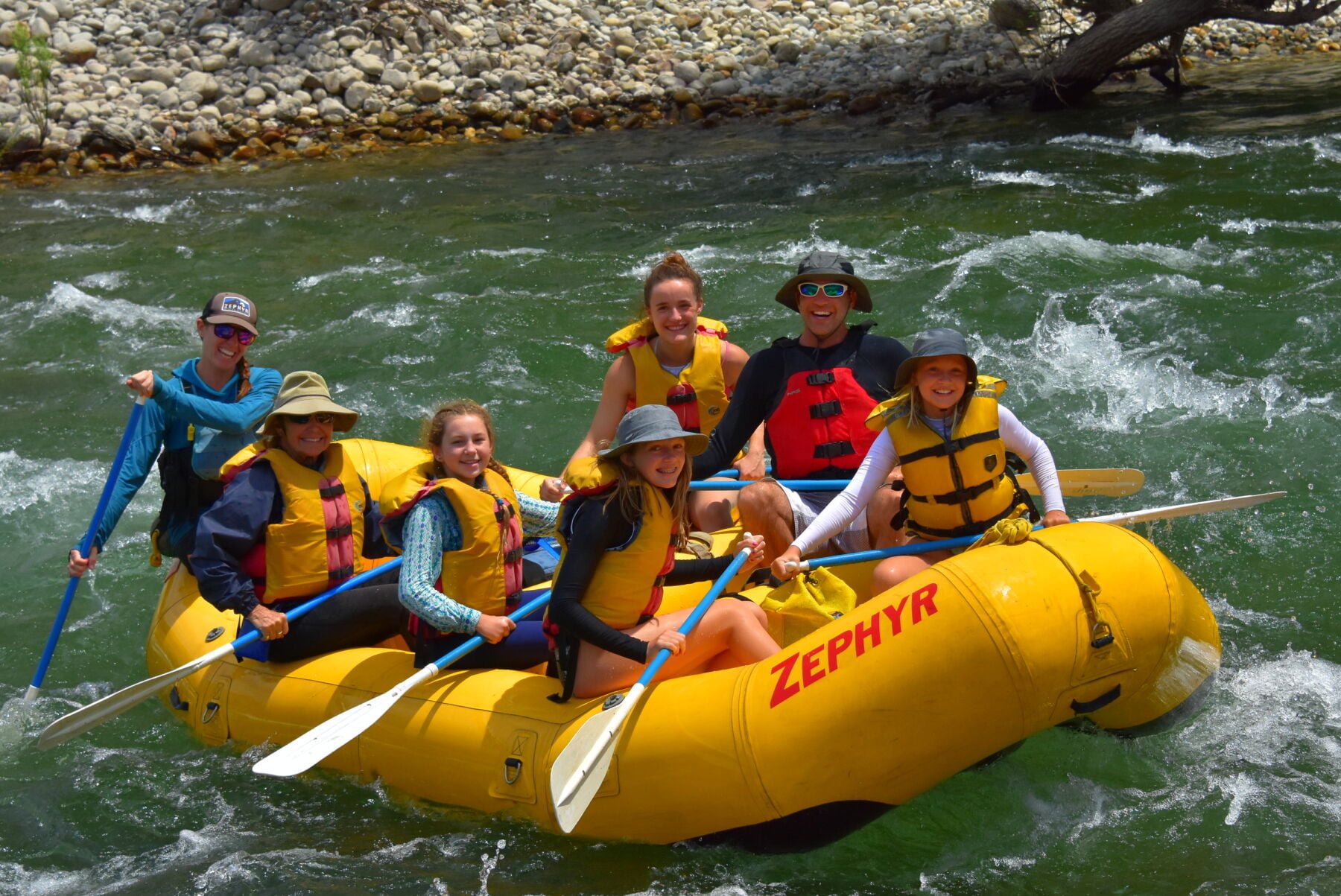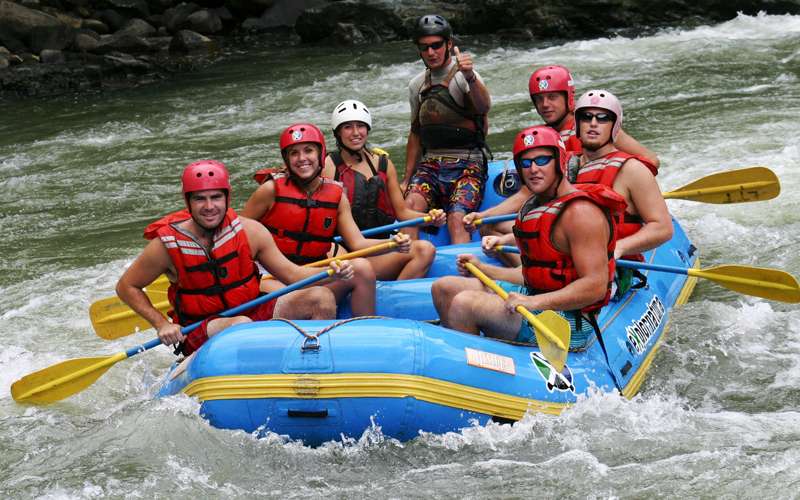Vital Skills for Water Rafting
Grasping the art of water rafting calls for a combination of accurate skills and expertise to navigate the unforeseeable currents of rivers, making it a thrilling yet possibly unsafe activity. From understanding the ins and outs of river characteristics to swiftwater rescue strategies and seamless team communication, the journey down the river demands a mix of expertise and adaptability. White Water Rafting Colorado.
Paddling Methods
Grasping effective paddling strategies is crucial for navigating water rafts safely and efficiently. Proper paddling not only drives the plethora onward yet additionally assists in maneuvering and steering via varying water conditions. One fundamental technique is the forward stroke, where paddlers dip the blade fully into the water and draw it back together with the plethora to create propulsion. Timing and control are vital to ensure that all paddlers remain in sync, taking full advantage of the power of each stroke.
In addition to the forward stroke, the draw stroke is important for making quick changes or drawing the boating closer to a things. By putting the paddle blade vertical to the water's surface and drawing the water in the direction of the boating, paddlers can efficiently transform the vessel's direction. The backstroke serves as a useful tool for backing up or reducing down the boating when necessary.
River Checking Out
Effective paddling techniques, such as the forward stroke and attract stroke, play a crucial duty in analyzing and navigating river currents, an ability known as river analysis. River reading involves the capability to assess the rate, depth, and direction of the water circulation to make informed choices while navigating rapids. By recognizing how the water moves obstacles and via different channels, rafters can pick the most effective path to safely go across the river.
One key facet of river reading is acknowledging various kinds of currents, consisting of waves, swirls, and hydraulics, and understanding exactly how they can influence the raft. Eddies, as an example, are areas where the water moves in a circular motion, usually providing chances for remainder or tactical maneuvers. Waves can suggest the visibility of challenges or rocks, calling for fast modifications in paddling strategy. Hydraulics, frequently recognized as "holes," are locations where water recirculates back upstream, positioning prospective threats to rafts.
Understanding the ability of river reading is vital for risk-free and satisfying rafting experiences, allowing paddlers to navigate difficult waters with confidence and precision.

Swiftwater Rescue
Comprehending swiftwater rescue strategies is essential for water rafting fanatics to respond efficiently in emergency situation scenarios on fast-flowing rivers. Swiftwater rescue involves a set of specialized abilities and knowledge targeted at safely drawing out people from swift-moving water. One vital aspect of swiftwater rescue is recognizing the dangers existing in fast-flowing rivers, such as filters, undercut rocks, and solid currents, to intend and execute successful rescue procedures.
Correct tools is essential for swiftwater rescue, including throw bags, rescue ropes, helmets, and individual flotation protection tools. Rafting fanatics have to be experienced at utilizing this tools in high-stress situations to ensure the security of themselves and others. In addition, swiftwater rescue methods often include synergy and control amongst rafters to implement intricate rescue you can find out more maneuvers properly.
Learning swiftwater rescue is highly recommended for people participating in water rafting activities, as it outfits them with the necessary abilities to take care of emergency situations quickly and successfully. White Water Rafting Colorado. By exercising and comprehending swiftwater rescue methods, water rafting enthusiasts can enhance their safety which of their fellow rafters on tough river expeditions
Team Interaction
Reliable synergy click for more info in water rafting depends heavily on smooth communication among employee to make sure collaborated and safe navigating through challenging river problems. Clear and succinct interaction is crucial for the success of any kind of rafting expedition. Team participants should have the ability to successfully share crucial information such as paddling commands, caution signals, and navigational directions.
In the fast-paced and usually unforeseeable atmosphere of river rafting, prompt and precise interaction can imply the distinction between a potential calamity and a successful run - White Water Rafting Colorado. Each employee plays a crucial role in the general interaction process, whether it be paying attention attentively to the overview's guidelines, relaying information to various other paddlers, or signaling for assistance when needed
Developing a common language and communication system prior to hitting hop over to these guys the water is necessary. This ensures that everybody gets on the very same page and recognizes exactly how to connect effectively during the rafting journey. By cultivating a culture of open interaction and common respect, rafting groups can boost their performance and safety on the river.

Safety And Security Procedures
In the context of water rafting, the foundation of group communication established throughout expeditions is additional reinforced with rigorous adherence to security protocols. Safety procedures are critical in guaranteeing the health of both rafters and guides throughout water rafting expeditions. One essential security method is the proper putting on of personal flotation protection devices (PFDs) by every individual on the plethora. PFDs are essential in emergency situations to keep individuals afloat and offer buoyancy. In addition, rafters must be well-versed in swiftwater rescue strategies and procedures in case of somebody dropping overboard or if the boating tips over.
An additional key safety procedure is the extensive briefing supplied by overviews prior to starting a rafting journey. This instruction typically includes info on paddling methods, what to do in situation of different emergencies, and signals utilized for interaction during the journey. It is necessary to have actually assigned safety and security kayakers going along with the group to offer immediate assistance if required. By strictly adhering to these safety methods, water rafting tours can be both risk-free and exhilarating for all participants involved.
Conclusion
Finally, understanding vital skills for water rafting is critical for a satisfying and risk-free experience on the river. Paddling techniques, river analysis, swiftwater rescue, group communication, and safety and security methods are all vital components that add to a successful rafting trip. By honing these skills, rafters can navigate challenging waters with confidence and make certain the security of themselves and their staff member.
Mastering the art of water rafting needs a combination of exact abilities and understanding to browse the unpredictable currents of rivers, making it a thrilling yet potentially harmful activity. By putting the paddle blade vertical to the water's surface and pulling the water in the direction of the raft, paddlers can properly change the vessel's direction.Recognizing swiftwater rescue techniques is important for water rafting fanatics to react efficiently in emergency situation scenarios on fast-flowing rivers.Effective team effort in water rafting counts greatly on seamless interaction amongst group members to guarantee worked with and secure navigation with tough river problems.In conclusion, grasping necessary abilities for water rafting is vital for a safe and pleasurable experience on the river.